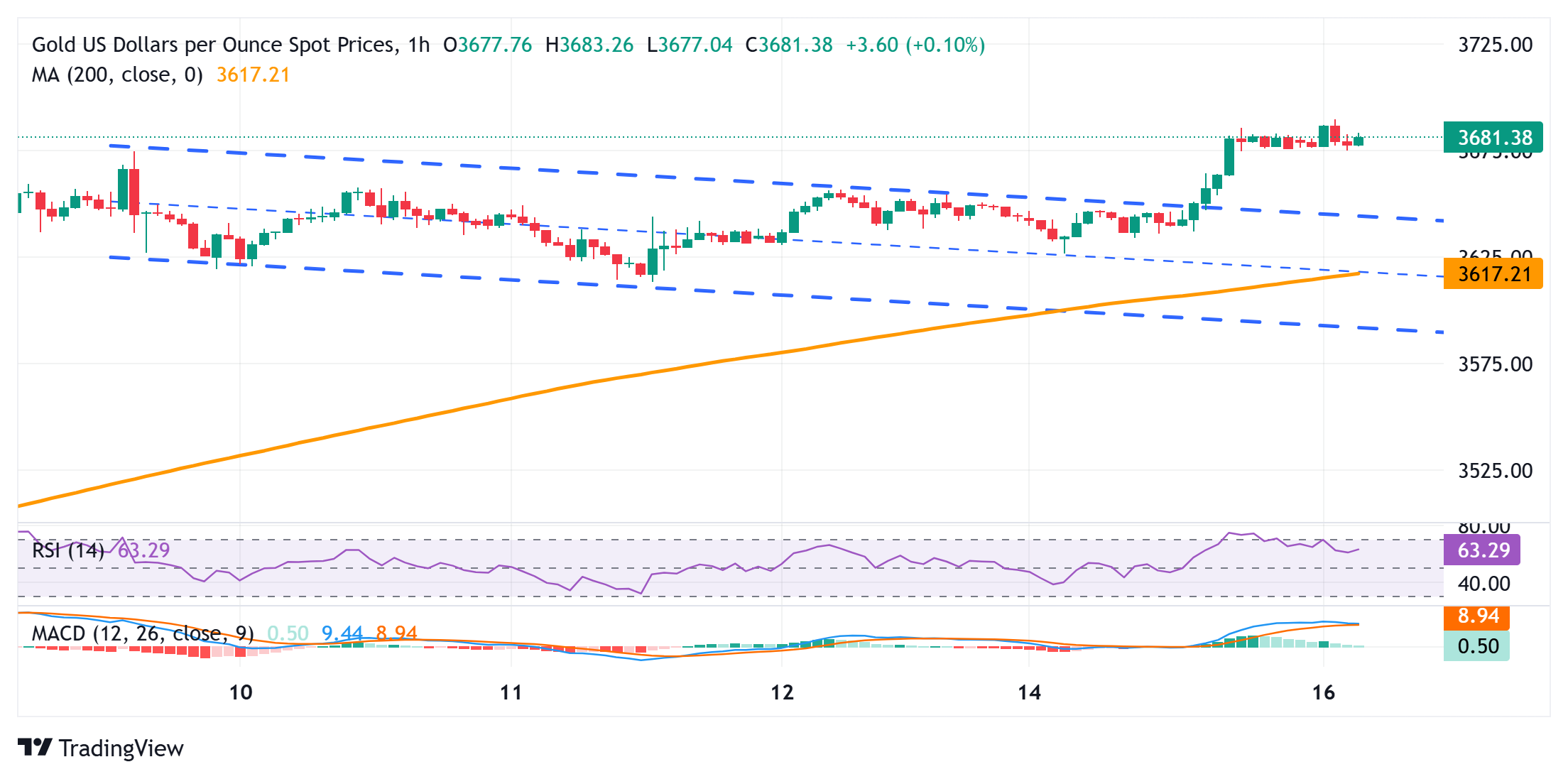Created
: 2025.09.16














![]() 2025.09.16 12:59
2025.09.16 12:59
Gold (XAU/USD) retreats slightly after touching a fresh record high, around the $3,689-3,690 region during the Asian session on Tuesday, amid some repositioning trade ahead of key central bank events. The US Federal Reserve (Fed) will announce its decision at the end of a two-day meeting on Wednesday and is expected to lower borrowing costs by 25-basis-point (bps) amid signs of a softening job market. The focus, however, will be on updated economic projections and Fed Chair Jerome Powell's tone at the post-meeting press conference. Investors will look for cues about the Fed's rate-cut path, which, in turn, will influence the US Dollar (USD) price dynamics and provide a fresh directional impetus to the non-yielding yellow metal.
Furthermore, the Bank of Canada (BoC) policy update on Wednesday, the Bank of England (BoE) rate decision on Thursday, and the outcome of a two-day Bank of Japan (BoJ) meeting on Friday should infuse volatility around the Gold price. Hence, the pullback could be attributed to some profit-taking following the recent parabolic rise and the risk-on mood, amid overbought conditions on the daily chart. Any meaningful corrective slide, however, seems elusive in the wake of rising geopolitical tensions, which might continue to act as a tailwind for the safe-haven bullion. Hence, it will be prudent to wait for strong follow-through selling before confirming that the XAU/USD pair has topped out ahead of the $3,700 round figure.

The overnight strong move up marked a fresh breakout through a bullish flag pattern. That said, the daily Relative Strength Index (RSI) is holding well above the 70.0 mark, pointing to extremely overbought conditions and warranting some caution before positioning for any further gains. This suggests that the XAU/USD pair might struggle to build on the momentum beyond the $3,700 round figure, which should now act as a key pivotal point.
Meanwhile, any meaningful corrective slide is likely to attract fresh buyers and find decent support near the flag pattern breakout point, around the $3,645 region. However, some follow-through selling, leading to a subsequent fall below the $3,633 horizontal zone, could drag the Gold price to the $3,610-3,600 area. A convincing break below the latter could pave the way for deeper losses and expose the $3,500 psychological mark, with some intermediate support near the $3,562-3,560 region.
Gold has played a key role in human's history as it has been widely used as a store of value and medium of exchange. Currently, apart from its shine and usage for jewelry, the precious metal is widely seen as a safe-haven asset, meaning that it is considered a good investment during turbulent times. Gold is also widely seen as a hedge against inflation and against depreciating currencies as it doesn't rely on any specific issuer or government.
Central banks are the biggest Gold holders. In their aim to support their currencies in turbulent times, central banks tend to diversify their reserves and buy Gold to improve the perceived strength of the economy and the currency. High Gold reserves can be a source of trust for a country's solvency. Central banks added 1,136 tonnes of Gold worth around $70 billion to their reserves in 2022, according to data from the World Gold Council. This is the highest yearly purchase since records began. Central banks from emerging economies such as China, India and Turkey are quickly increasing their Gold reserves.
Gold has an inverse correlation with the US Dollar and US Treasuries, which are both major reserve and safe-haven assets. When the Dollar depreciates, Gold tends to rise, enabling investors and central banks to diversify their assets in turbulent times. Gold is also inversely correlated with risk assets. A rally in the stock market tends to weaken Gold price, while sell-offs in riskier markets tend to favor the precious metal.
The price can move due to a wide range of factors. Geopolitical instability or fears of a deep recession can quickly make Gold price escalate due to its safe-haven status. As a yield-less asset, Gold tends to rise with lower interest rates, while higher cost of money usually weighs down on the yellow metal. Still, most moves depend on how the US Dollar (USD) behaves as the asset is priced in dollars (XAU/USD). A strong Dollar tends to keep the price of Gold controlled, whereas a weaker Dollar is likely to push Gold prices up.
![]()
Created
: 2025.09.16
![]()
Last updated
: 2025.09.16

FXStreet is a forex information website, delivering market analysis and news articles 24/7.
It features a number of articles contributed by well-known analysts, in addition to the ones by its editorial team.
Founded in 2000 by Francesc Riverola, a Spanish economist, it has grown to become a world-renowned information website.
We hope you find this article useful. Any comments or suggestions will be greatly appreciated.
We are also looking for writers with extensive experience in forex and crypto to join us.
please contact us at [email protected].
Disclaimer:
All information and content provided on this website is provided for informational purposes only and is not intended to solicit any investment. Although all efforts are made in order to ensure that the information is correct, no guarantee is provided for the accuracy of any content on this website. Any decision made shall be the responsibility of the investor and Myforex does not take any responsibility whatsoever regarding the use of any information provided herein.
The content provided on this website belongs to Myforex and, where stated, the relevant licensors. All rights are reserved by Myforex and the relevant licensors, and no content of this website, whether in full or in part, shall be copied or displayed elsewhere without the explicit written permission of the relevant copyright holder. If you wish to use any part of the content provided on this website, please ensure that you contact Myforex.
Myforex uses cookies to improve the convenience and functionality of this website. This website may include cookies not only by us but also by third parties (advertisers, log analysts, etc.) for the purpose of tracking the activities of users. Cookie policy